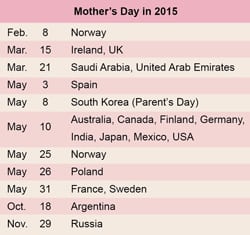 Wherever your customers reside, in the U.S. or overseas, it helps to know when they are most likely to shop for your products or services. For instance, if you sell jewelry, chocolate, or flowers, you already know that the vast majority of those items are purchased in the days and weeks leading up to Valentine’s Day and Mother’s Day. But do you know whether these holidays occur where your cross-border customer resides? Are they on the same dates as in the U.S. or different dates? Which other holidays or events in your target countries might provide fodder for online promotions?
Wherever your customers reside, in the U.S. or overseas, it helps to know when they are most likely to shop for your products or services. For instance, if you sell jewelry, chocolate, or flowers, you already know that the vast majority of those items are purchased in the days and weeks leading up to Valentine’s Day and Mother’s Day. But do you know whether these holidays occur where your cross-border customer resides? Are they on the same dates as in the U.S. or different dates? Which other holidays or events in your target countries might provide fodder for online promotions?
On February 14th, consumers in many countries—not just Americans—show their love for one another with gifts and special outings. In Japan, South Korea, and Taiwan, March 14th is an equally important date on the calendar. That’s when Valentine’s Day recipients “reply” in kind with superior gifts. (An equivalent gift signals a severing of the relationship.) Chinese and Brazilians, on the other hand, honor their loved ones in the summer instead, with gifts on the Double Seven Festival and Dia dos Namorados respectively.
Multiple Mother’s Days
As for mothers, across the globe more than a dozen different dates honor them. (See chart.)
Mothers and lovers aren’t the only recipients of a special day that retailers can leverage. International Women’s Day, on March 8th, offers an excellent opportunity in numerous countries to run a fashion-related promotion. And Children’s Day in many Asian countries would be a good time for a toy sale.
Special Seasons and Long Weekends
In many countries, consumers spend three-fourths of their gift-giving budget between mid-November and mid-December. In Russia, however, Christmas shopping peaks in January. In China, more money is spent on gifts the month before the Chinese New Year holiday, which starts February 18th this year. And in Islamic countries, gift spending peaks before Eid-Al-Fitr and Eid-Al-Adha, the dates of which change every year because they are based on a Julian calendar.
Even if there isn’t a recognized holiday such as Christmas or Mother’s Day, consumers tend to shop more on long weekends, when they have the adjacent Friday or Monday as a day off from work. It helps to know when those long weekends occur and whether they are associated with a special holiday—such as Republic/Remembrance/Memorial/Independence Day—or just a seasonal bank holiday.
The beginning of seasons and the months prior to a new school year can also provide wonderful opportunities for promotions in other countries. The official start of summer—Midsummer’s Eve—does not commend much attention in the U.S. but is celebrated heartily in the Nordic countries. Since the Australian school year typically starts in late January or early February, back-to-school sales are already revving up “Down Under.”
Any retailer engaged in cross-border selling should take time to note on a calendar the important ecommerce-related events in the countries where your shoppers reside. (For starters, check out ecommercecalendar.com.) With this information in hand, you can generate new ideas for marketing promotions as well as repurpose campaigns for different markets—for instance, a Mother’s Day promotion in March for your British shoppers and a similar one in May for your consumers in Australia and Canada.
An Important Caveat
Keep in mind, however, that it is not enough to know the important dates in your target country. Just because two countries each have the same holiday and even celebrate it on the same day does not mean the same exact campaign or promotion can be used in both places. At a minimum, retailers should take care to use the appropriate language and terminology. For instance, January 6th is called Epiphany in English-speaking countries, but in Spain and some Latin American countries, it is El Día de los Reyes (Day of the Kings).
Speaking of Epiphany, many holidays have religious roots but are no longer recognized by the majority of the population as such, or have both secular and religious meaning. Christmas and Easter are perfect examples of the latter in the U.S. and many other countries. Your product and how well you know your target audience will help you know whether to go with a secular or religious theme in your marketing campaigns. In the countries in which religious holidays are observed as religious by practically everyone, it is important to know at least the basics about each religious holiday and its modern-day significance (or lack of significance) to typical shoppers before you plan a campaign around it.
For instance, countries with a strong Catholic influence—such as those colonized by Spaniards years ago—count the Assumption of Mary, Whit Sunday/Monday, and the Feast of the Immaculate Conception as national holidays. That means more time for consumers to shop online; however, calling your promotion an Assumption of Mary sale might be considered sacreligious. Better to have a sale that just happens to coincide with that particular holiday’s day off or long weekend.
Same goes for other Christian, Jewish, or Muslim holidays. If a holiday centers around fasting or denying oneself—such as Ash Wednesday, Yom Kippur, or Ramadan, it’s probably not a good idea to tie a campaign that supports consumerism to that particular holiday. Eid-Al-Fitr, on the other hand, is a good holiday to leverage because it celebrates the end of Ramadan and the breaking of the fast.
As always, “glocalization”—global reach with local feel—is critical for success.
Maciej Piwoni, head of digital marketing at Global Ecommerce and Logistics Management eShopWorld.